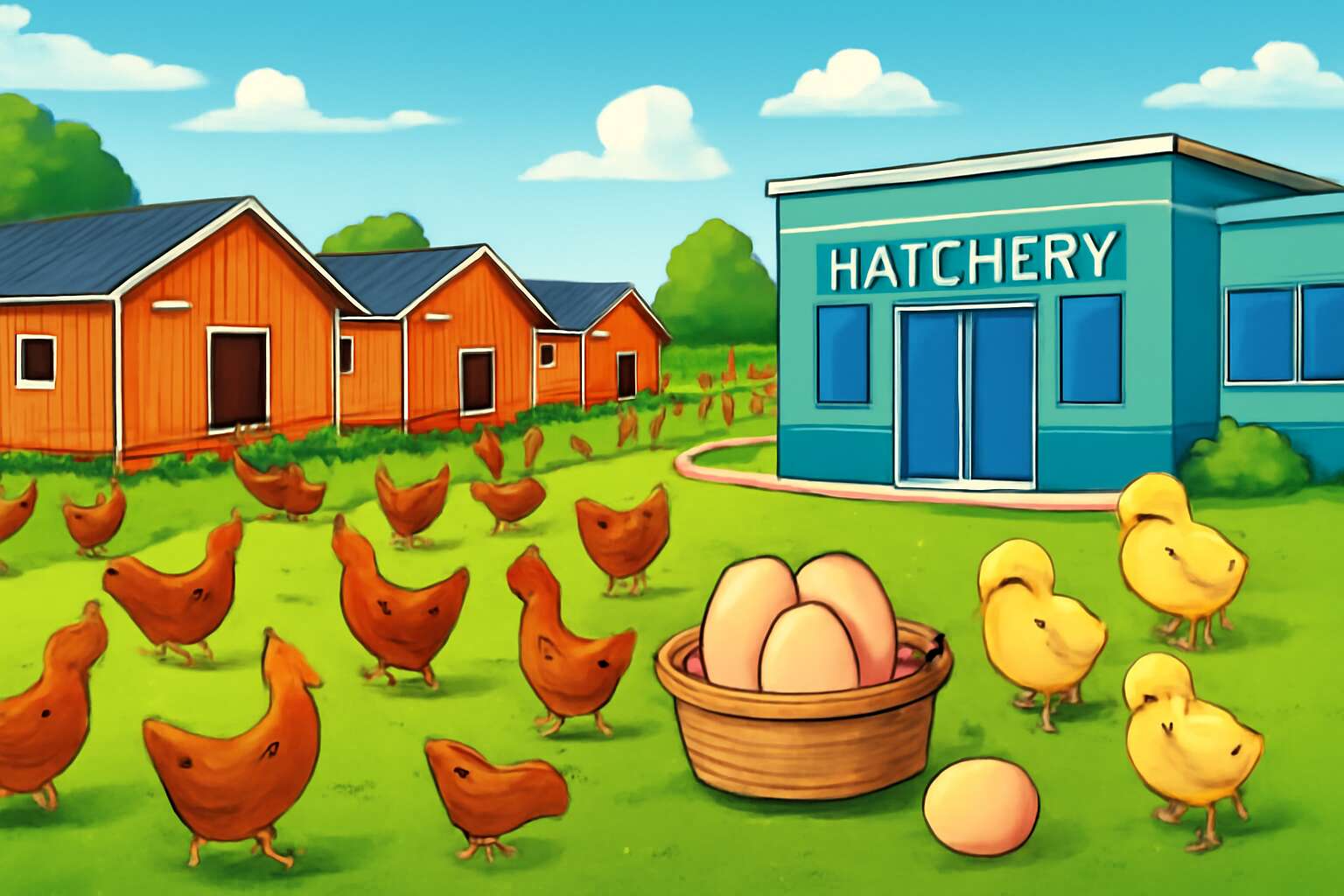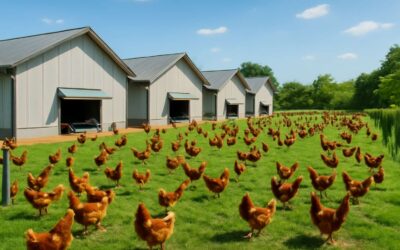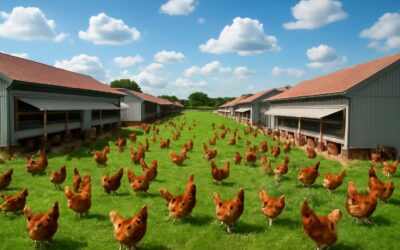Understanding Poultry Farming and Hatchery Operations
Types of Poultry Farms – Array
In the realm of poultry farm and hatchery operations, understanding the intricacies of poultry farming is akin to unlocking a hidden world of vitality and resilience. At its core, poultry farming is an ancient craft, blending science and tradition to produce the humble yet vital bird that has sustained societies for centuries. Modern poultry farm and hatchery establishments harness advanced technology and meticulous management to optimise hatch rates, health, and productivity, transforming this age-old craft into a thriving industry.
There are various types of poultry farms, each tailored to specific goals and scales of operation. For instance, some farms focus exclusively on egg production, while others specialise in broiler meat. A typical poultry farm may be classified as:
- Broiler farms—dedicated to raising chickens for meat, often on a large scale with rapid turnover cycles.
- Layer farms—focused on producing eggs, with careful attention to hen welfare and egg quality.
- Breeding farms—where genetic lines are developed to enhance desirable traits such as growth rate or disease resistance.
Within the framework of a poultry farm and hatchery, the initial stages are crucial—hatching eggs are carefully incubated under controlled conditions, ensuring the highest hatchability rates. The hatchery acts as the heartbeat of the operation, transforming fertilised eggs into vibrant chicks ready to begin their journey into commercial poultry production. With each hatch, the cycle of life continues, driven by precision and a touch of the extraordinary that makes poultry farming a truly captivating enterprise.
Role of a Hatchery in Poultry Farming – Array
In the enchanting world of poultry farm and hatchery operations, precision and care orchestrate a symphony of life. The role of a hatchery is nothing short of magical, serving as the vital heartbeat that transforms fertilised eggs into the vibrant chicks that will eventually grace the poultry industry. Every hatchery is a sanctuary of science and art, where temperature, humidity, and ventilation are meticulously calibrated to optimise hatchability rates and ensure healthy, resilient chicks emerge into the world.
Within this delicate process, hatcheries play an essential role in ensuring the continuity of quality poultry stock. They act as guardians of genetic excellence, nurturing the next generation of broiler chickens, layers, or breeders. The hatchery’s success hinges on advanced incubation technology and rigorous management, which together create an environment where life can flourish. For those invested in the future of poultry farming, understanding the inner workings of hatchery operations reveals the true marvel behind the scenes—where every egg holds the promise of vitality and growth.
Key Components of a Poultry Farm and Hatchery
Facilities and Infrastructure – Array
Behind every thriving poultry farm and hatchery lies a carefully orchestrated symphony of essential components, each playing a vital role in ensuring optimal productivity and animal welfare. The infrastructure must be robust yet adaptable, designed to meet the unique needs of poultry farming with precision and care. From climate-controlled housing to efficient feed delivery systems, every element works in harmony to create a sanctuary for growth and development.
Critical to this harmony are the key components that form the backbone of a successful poultry farm and hatchery. These include well-ventilated poultry houses, reliable water supply systems, and temperature regulation mechanisms that mimic the natural environment. Proper biosecurity measures, sanitation stations, and waste management facilities are also indispensable in preventing disease and maintaining high standards of health. An organised layout, featuring designated zones for incubation, brooding, and processing, ensures smooth operations and minimises stress for the birds.
- Climate control systems for optimal temperature and humidity
- Efficient feed and water supply infrastructure
- Segregated zones for incubation and brooding
- Biosecurity and waste management facilities
The infrastructure of a poultry farm and hatchery is more than just a physical space; it’s a living, breathing ecosystem that nurtures poultry from hatchlings to harvest. The thoughtful integration of these key components transforms a simple farm into a thriving hub of agricultural innovation and sustainability, promising a future where poultry farming is both productive and humane.
Equipment and Technology – Array
The heartbeat of any successful poultry farm and hatchery lies in its key components—tools and technology that transform raw potential into thriving flocks. Advanced poultry farm and hatchery equipment isn’t just about efficiency; it’s about creating an environment where poultry can flourish naturally. From automated feeding systems to sophisticated climate control units, each piece plays a vital role in maintaining optimal conditions.
Modern poultry farm and hatchery technology often includes digital monitoring systems that track temperature, humidity, and feed intake in real time. This integration ensures prompt adjustments, minimising stress for the birds and maximising growth rates. Crucially, biosecurity measures such as disinfectant sprayers and controlled access points act as the first line of defence against disease, safeguarding the health of the entire operation.
In essence, the right combination of equipment and technological innovation helps to craft a resilient ecosystem—one where poultry are nurtured from hatchling to harvest with precision and care. The evolution of these key components continues to shape the future of poultry farming, promising sustainability and productivity in tandem.
Best Practices in Poultry Farm and Hatchery Management
Biosecurity and Disease Control – Array
Maintaining a resilient biosecurity protocol is the backbone of a successful poultry farm and hatchery. In an industry where a single breach can decimate entire flocks, vigilant disease control measures are non-negotiable. The real challenge lies in weaving meticulous hygiene practices into daily routines—disinfecting footwear, sanitising equipment, and controlling visitor access are just the beginning.
A comprehensive disease prevention strategy often involves a layered approach. For example, implementing strict quarantine procedures for new stock and regularly monitoring bird health can significantly reduce the risk of outbreaks. Proper waste management and air filtration systems act as silent sentinels, safeguarding the flock from airborne pathogens.
In the complex ecosystem of a poultry farm and hatchery, understanding and applying best practices in biosecurity isn’t just good sense—it’s essential for sustaining productivity and health. After all, a healthy flock is the foundation of a thriving poultry operation, and disease control measures are the clearest path to achieving that goal.
Feed and Nutrition – Array
Optimal feed and nutrition are the cornerstones of a thriving poultry farm and hatchery. Ensuring that birds receive a balanced diet boosts growth rates, enhances immunity, and reduces disease susceptibility. Quality feed ingredients and precise formulation are vital for maintaining flock health and productivity.
In a poultry farm and hatchery, it’s essential to tailor feeding strategies to different life stages. For example, starter feeds are high in protein to support rapid growth, while finisher feeds focus on energy efficiency. Regularly monitoring feed intake and adjusting formulations can prevent deficiencies and excesses that impair health.
Implementing a structured feeding schedule alongside modern technology—such as automated feeders—ensures consistency and reduces wastage. Here’s a quick overview of best practices:
- Prioritise high-quality, nutrient-dense ingredients.
- Maintain clean feeding equipment to prevent contamination.
- Adjust feed composition based on age, weight, and health status of the flock.
In the end, a well-managed feeding programme isn’t just about nutrition; it’s about fostering resilience and productivity within the poultry farm and hatchery. Healthy birds lead to higher hatchability, better flock uniformity, and ultimately, a more profitable operation.
Staff Training and Farm Safety – Array
In the bustling realm of poultry farm and hatchery management, the true magic lies in cultivating a team that embodies expertise and vigilance. Staff training is the keystone of a resilient operation—an ongoing journey that transforms routine tasks into a symphony of precision and care. Well-trained personnel understand that every action, from handling fragile chicks to maintaining immaculate facilities, influences the delicate balance of productivity and health.
Creating a culture of safety is equally vital. A comprehensive farm safety programme weaves awareness into daily routines, reducing accidents and safeguarding lives. Regular drills, clear signage, and protective gear are not mere formalities but vital shields against the unpredictable nature of poultry farming. Here, safety is not an afterthought but an integral part of the farm’s heartbeat.
Incorporating modern technology—such as digital training modules and automated safety alerts—further elevates standards. The harmony between knowledgeable staff and a secure environment fosters a thriving poultry farm and hatchery, where each bird’s journey from hatchling to harvest is guided by expertise and care. After all, a well-prepared team is the true guardian of a prosperous poultry enterprise!
Economic Aspects of Poultry Farming and Hatchery Business
Startup Costs and Investment – Array
The economic allure of establishing a poultry farm and hatchery is both captivating and complex, shimmering with promise yet demanding meticulous planning. A well-structured poultry farm and hatchery can transform a modest investment into a thriving enterprise, especially when the numbers align favourably. Initial startup costs encompass a spectrum of essentials—from land acquisition and infrastructure development to state-of-the-art hatchery technology—each a vital thread woven into the fabric of success.
Investment in quality equipment and biosecurity measures ensures the health of your flock, ultimately safeguarding your bottom line. The financial landscape of a poultry farm and hatchery is further enriched by the potential for rapid turnover and high demand in local markets. An astute entrepreneur will consider the following:
- Land and infrastructure development
- Hatchery machinery and equipment
- Feed systems and nutritional supplements
- Biosecurity and disease prevention protocols
- Labour and staff training
Understanding these facets is paramount for turning the dream of a flourishing poultry farm and hatchery into a tangible, profitable reality.
Profitability and Revenue Streams – Array
Economic viability is the heartbeat of any successful poultry farm and hatchery. With global demand for poultry products rising steadily, the potential for profit is both promising and dynamic. A well-managed poultry farm and hatchery can generate multiple revenue streams, from the sale of broiler chickens and layer hens to hatchling sales and poultry products like eggs and meat. The key lies in diversifying income sources and maintaining high standards of quality and biosecurity.
Revenue streams often include:
- Sale of live poultry (broilers, layers, breeders)
- Hatching eggs and day-old chicks
- Processed poultry meat and eggs
- Poultry manure and by-products
Profit margins hinge on efficient feed management, disease control, and market access. An optimised poultry farm and hatchery can turn a modest investment into a thriving enterprise, driven by the ever-present demand for poultry products across local and international markets. The industry’s resilience and adaptability make it a compelling choice for entrepreneurs seeking a lucrative venture rooted in the timeless appeal of poultry farming.
Market Trends and Opportunities – Array
The burgeoning demand for poultry products continues to reshape the landscape of the poultry farm and hatchery industry, with global markets expanding at an unprecedented rate. This relentless growth underscores an intrinsic truth: poultry farming is not merely an agricultural endeavour but a compelling economic force capable of transforming livelihoods. Market trends reveal a shifting preference towards processed poultry meat and organic eggs, reflecting consumer awareness of quality and sustainability. For those who grasp the nuances of this evolving sector, the opportunities are both vast and nuanced.
In particular, the industry’s resilience is underpinned by its capacity to diversify revenue streams. A thriving poultry farm and hatchery can capitalise on multiple avenues, including the sale of live broilers, layers, breeders, and hatchling sales. Additionally, processed poultry products and poultry manure offer supplementary income, bolstering financial stability. The appeal lies in the ability to adapt swiftly to market fluctuations, leveraging innovations in feed technology, biosecurity, and marketing strategies. As the demand for high-quality poultry products intensifies, entrepreneurs with a keen eye for market trends can carve out lucrative niches within this dynamic sector.
- Increased consumer awareness about poultry product origins fuels demand for organic and ethically farmed options.
- The rise of export markets opens new avenues for poultry farm and hatchery owners seeking international partnerships.
- Technological advancements, such as automation and data analytics, optimise production efficiency and market responsiveness.
For those committed to navigating this vibrant economic terrain, understanding market trends and aligning operations accordingly can transform a modest investment into a lucrative enterprise. The interplay of consumer preference, technological innovation, and strategic diversification forms the backbone of sustainable growth within the poultry farm and hatchery sector — a testament to its enduring allure and promising future.
Sustainable Practices in Poultry Farming
Environmental Impact Reduction – Array
In an era where ecological footprint matters more than ever, sustainable practices in poultry farm and hatchery operations are no longer optional—they’re imperative. The poultry industry, often portrayed as the bad boy of agriculture, can actually lead the charge in environmental impact reduction. Embracing eco-friendly methods not only saves the planet but also boosts your farm’s reputation among eco-conscious consumers eager for ethically produced poultry products.
Implementing renewable energy sources, such as solar panels or biogas systems, can dramatically cut down greenhouse gas emissions. Moreover, innovative waste management techniques—like composting poultry manure or converting it into biogas—transform what was once waste into a valuable resource. For poultry farm and hatchery operators, adopting these sustainable strategies isn’t just a noble gesture; it’s a savvy move towards long-term profitability. Here’s a quick glimpse of some eco-smart practices:
- Utilising renewable energy sources
- Efficient water management and recycling
- Reducing reliance on antibiotics through natural health practices
- Implementing eco-friendly feed options that minimise environmental impact
By championing these environmentally friendly initiatives, poultry farm and hatchery owners can reduce their ecological impact while maintaining a competitive edge in a market increasingly driven by sustainability. After all, the future of poultry farming isn’t just about eggs and broilers—it’s about nurturing a greener, cleaner world one poultry farm at a time!
Animal Welfare and Ethical Farming – Array
In the evolving landscape of poultry farm and hatchery operations, animal welfare and ethical farming are no longer optional—they are fundamental to long-term success. Modern consumers are increasingly conscious of the origins of their food, demanding transparency and compassion in how poultry is raised. Prioritising humane treatment, such as providing ample space, natural light, and enriched environments, not only improves the quality of life for the birds but also enhances productivity and product quality.
Implementing sustainable practices within poultry farm and hatchery settings reflects a commitment to ethical farming. This can include adopting cage-free systems or free-range methods that respect natural behaviours. Additionally, embracing natural health practices reduces reliance on antibiotics, fostering healthier flocks and aligning with global trends towards organic and ethically produced poultry.
Ultimately, ethical poultry farming cultivates trust among consumers and elevates industry standards. As the sector progresses, integrating animal welfare with eco-conscious methods creates a resilient foundation for a humane, sustainable future in poultry farm and hatchery operations. The pursuit of ethical farming isn’t merely a moral choice—it’s a strategic imperative that shapes the identity and integrity of the poultry industry in an increasingly conscientious world.
Innovations in Poultry Hatchery – Array
Sustainable practices are revolutionising poultry farm and hatchery operations, blending innovation with responsibility. In an industry where efficiency often takes centre stage, embracing eco-friendly methods can lead to both ecological and economic benefits. For example, integrating renewable energy sources, like solar panels, reduces reliance on fossil fuels—cutting costs and lowering carbon footprints.
Technological advancements are also playing a crucial role. Automated climate control systems optimise temperature and humidity, creating optimal environments for poultry, which enhances overall health and productivity. Additionally, waste management innovations, such as biogas digesters, transform manure into valuable energy, turning a waste product into a resource.
Furthermore, sustainable poultry farming often involves adopting natural ventilation systems and water conservation techniques, ensuring minimal environmental impact. Some farms are even exploring innovative feed formulations that reduce waste and improve nutrient absorption, aligning with global trends towards organic and ethically produced poultry. Embracing these innovations not only boosts sustainability but also positions poultry farm and hatchery operations as leaders in responsible food production.
Regulatory Compliance and Certifications
Legal Requirements – Array
Ensuring compliance with legal requirements is the backbone of a reputable poultry farm and hatchery. Regulations are designed to uphold standards that protect animal welfare, public health, and environmental sustainability. For any poultry farm and hatchery, understanding and adhering to these legal frameworks isn’t just a bureaucratic obligation; it’s a commitment to responsible farming.
Legislation often stipulates specific standards for biosecurity, waste management, and the use of antibiotics. Failure to comply can lead to hefty penalties or even the closure of the farm. To facilitate smooth operations, many poultry farm and hatchery owners pursue relevant certifications such as the Red Tractor Assurance or RSPCA Welfare Standards. These certifications serve as proof of adherence to strict guidelines and bolster consumer trust.
In addition, legal requirements may include:
- Proper licensing and registration of the poultry farm and hatchery
- Regular health and safety inspections
- Environmental impact assessments
By prioritising regulatory compliance, poultry farm and hatchery operators not only protect their livelihood but also contribute to a sustainable and ethical poultry industry that resonates with today’s conscientious consumers.
Quality and Certification Standards – Array
In an industry where reputation hinges on trust and transparency, regulatory compliance and certification standards serve as the bedrock of a reputable poultry farm and hatchery. Ensuring adherence to stringent legal requirements not only safeguards animal welfare and public health but also elevates a farm’s standing within a competitive market. The phrase ‘trust is the currency of sustainable farming’ resonates profoundly here, emphasising that certification—such as the RSPCA Welfare Standards or Red Tractor Assurance—acts as a visible testament to a farm’s commitment to ethical practices.
For a poultry farm and hatchery, maintaining rigorous standards involves a meticulous approach to licensing, environmental impact assessments, and health and safety inspections. Many operators pursue certifications that demonstrate compliance with high-level guidelines—these serve as invaluable indicators to conscientious consumers seeking ethically produced poultry products. Certification standards often encompass:
- Animal welfare protocols
- Biosecurity measures
- Waste management procedures
By embedding these standards into daily operations, poultry farm and hatchery owners foster an environment of excellence and integrity, reinforcing their position within an industry increasingly driven by consumer values and ecological responsibility. This commitment not only elevates quality assurance but also paves the way for sustainable growth amid evolving market demands.
Record Keeping and Traceability – Array
In the shadowed corridors of poultry farm and hatchery operations, where every detail whispers of meticulous control and silent vigilance, regulatory compliance and certifications are the unseen guardians of integrity. They serve as the cryptic code that assures consumers of the ethical origin and safety of poultry products, casting a spell of trust in a market teetering on the edge of transparency. Yet, beyond mere accreditation, the art of record keeping and traceability becomes the heartbeat of operational mastery, weaving a tapestry of accountability that withstands the probing gaze of auditors and inquisitive buyers alike.
For a poultry farm and hatchery, diligent record keeping is not merely bureaucratic drudgery but a sacred practice. It involves chronicling every movement— from feed batches and health treatments to hatch rates and environmental conditions. This meticulous ledger enables farm operators to trace each poultry lot back through its lifecycle, ensuring that any anomalies or health concerns are swiftly identified and addressed. As the industry’s shadows grow longer with scrutiny, embracing robust traceability systems—such as digital tracking platforms and RFID tags—becomes vital.
Implementing a structured traceability system involves an ordered process:
- Recording detailed data at each stage of production.
- Maintaining accessible logs that can be audited at a moment’s notice.
- Ensuring data integrity through secure storage and regular backups.
In this dance of data and discipline, the poultry farm and hatchery stand resilient, cloaked in a fortress of compliance. Here, every record is a testament to transparency, transforming the farm from a mere producer into a bastion of ethical enterprise. Such unwavering commitment to traceability not only fortifies reputation but also safeguards the delicate balance of trust in an industry haunted by the specters of contamination and malpractice. It’s an unyielding quest—a silent vow that every chicken, every hatchling, bears the mark of integrity etched into history itself.




0 Comments